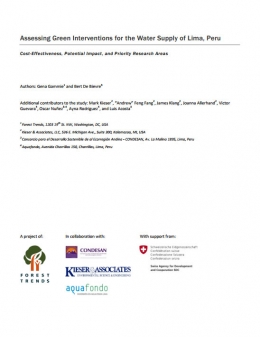Assessing Green Interventions for the Water Supply of Lima, Peru. Cost-Effectiveness, Potential Impact, and Priority Research Areas
Year:
2015
Publisher:
Forest Trends
This study assessed four such interventions in terms of cost and potential to improve dry season baseflows, namely: animal exclusion from overgrazed puna grasslands, introduction of rotational grazing practices on currently overgrazed puna grasslands, hydrological restoration of drained wetlands, and restoration of ancient infiltration infrastructure (amunas).
The assessment found that green interventions could substantially contribute to addressing the current dry season flow deficit at costs that are lower than, or competitive to, proposed gray infrastructure projects. Restoration of ancient infiltration infrastructure stood out as a particularly cost-effective and potentially high-impact green intervention, with the average marginal increase in baseflow costing an estimated $85,750 per m3/s. Our estimates indicate that all four green interventions are likely to be cost-competitive with gray infrastructure alternatives, with most well within a $0.25/m3 price point.
Further, the analysis suggests that if implemented at full scale these green interventions together could reduce the region’s baseflow deficit by 90 percent, or 2.74 m3 /s. In terms of annual volumetric impact, this corresponds to 58 million m3 of dry season water supply, more than the current dry season deficit in the region. Implementing the full portfolio of green interventions would cost an estimated $7.9 million per year.
The analysis recognizes that a lack of historical hydrological monitoring in the region leaves room for uncertainty around several of the assumptions used in this study. To account for this, the level of uncertainty associated with each assumption is qualitatively noted, and a range of potential average values is used to create ‘low’ and ‘high’ end estimates of cost-effectiveness and potential impact. Even under our most conservative assumptions, amuna restoration and hydrological restoration of wetlands remain more cost-effective than 11 other gray interventions considered. The study also suggests how targeted hydrological monitoring in the region could greatly improve understanding of the impact of green interventions in the region.
The methodological approach used in this report to estimate hydrologic benefits of interventions, included in the annexes to this report along with all calculations, may be applied for a variety of other applications. These include cost-benefit analysis for public investment projects, private sector contributions to water stewardship, and use of a quantifiable metric (baseflow in this case) for prioritizing green intervention projects within a water fund.
Work regions:
Publication Type:
Publication language:
English

Files:
